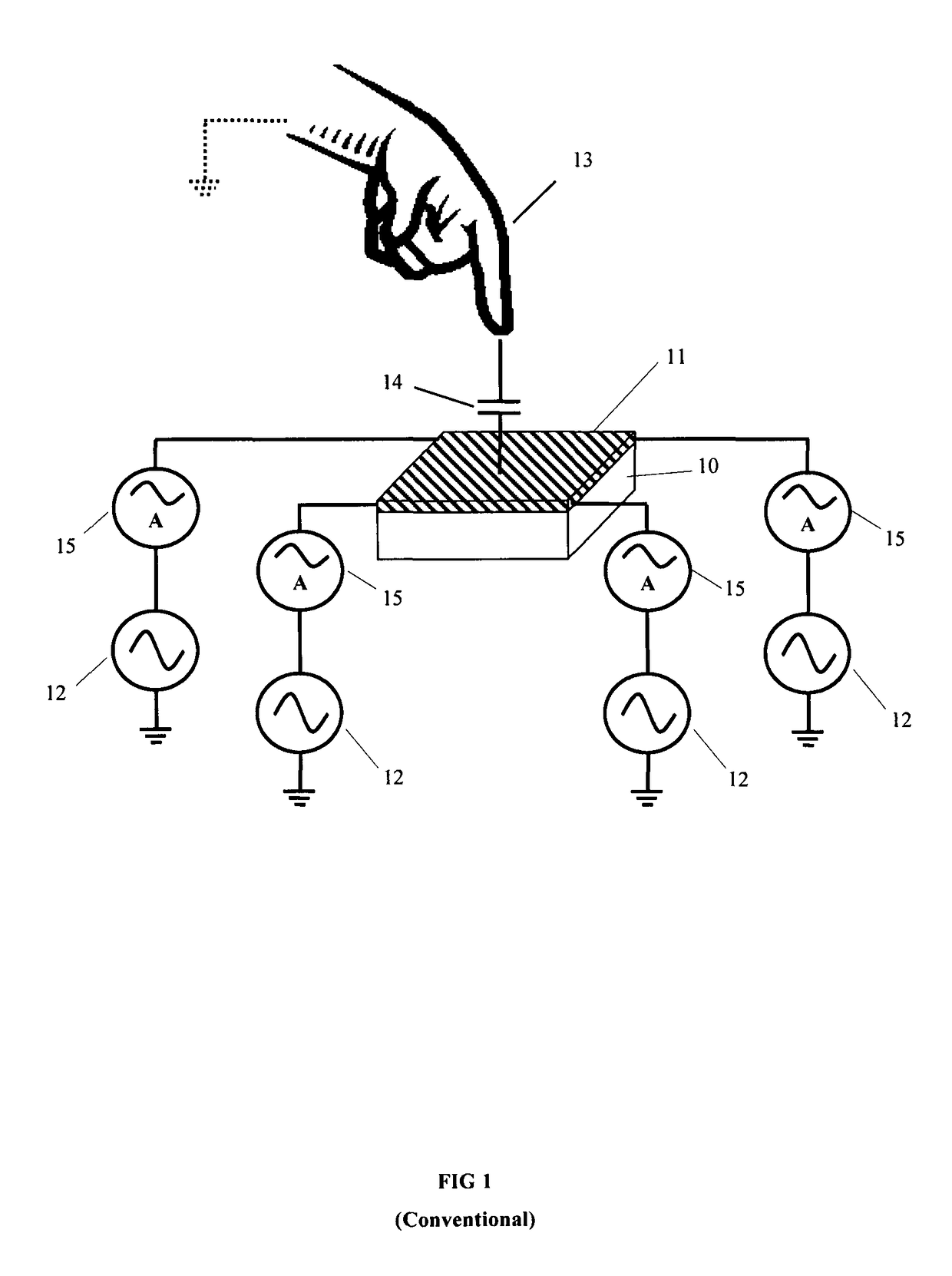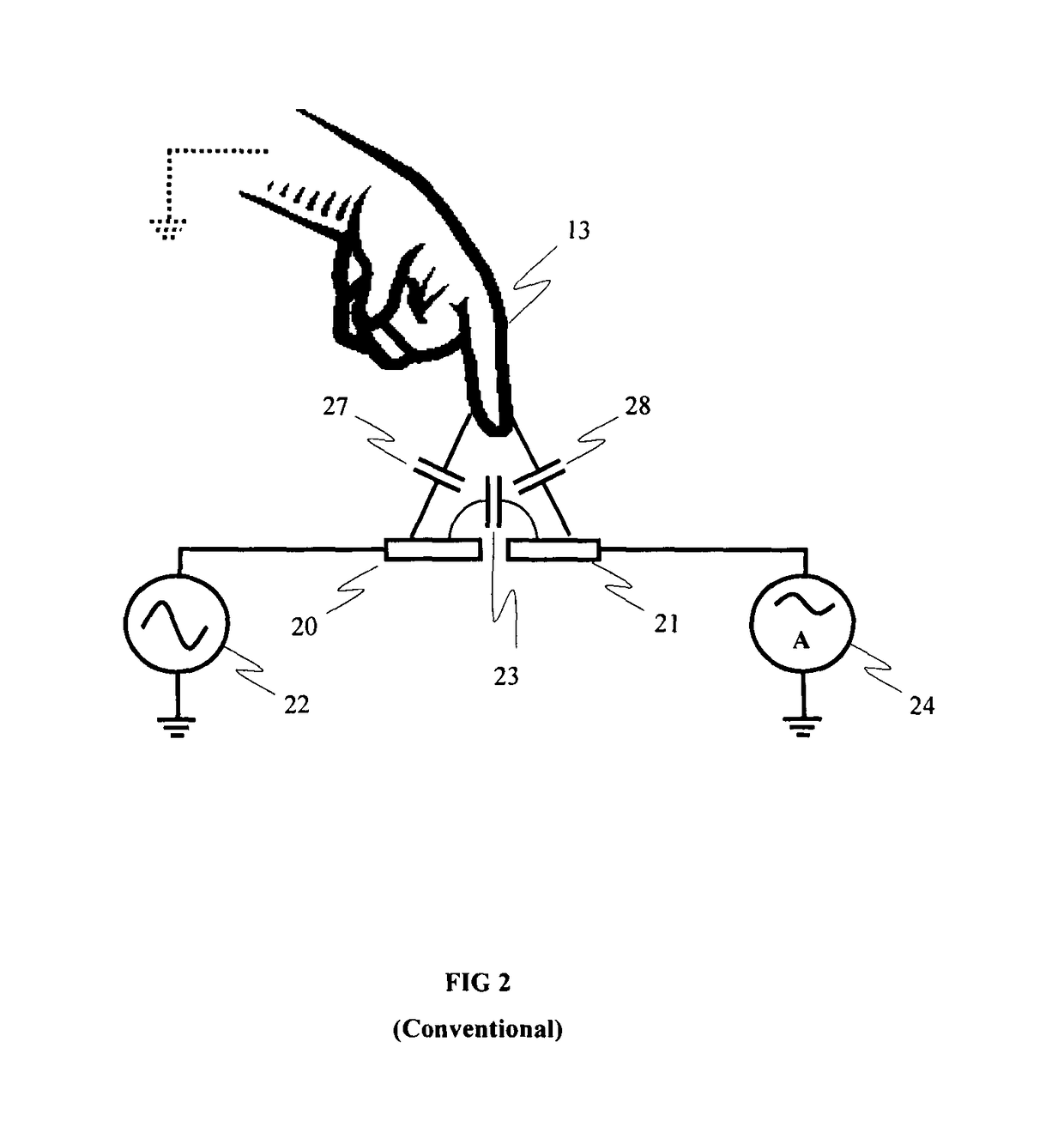Capacitive touch panel with height determination function
a capacitive touch panel and function technology, applied in the field of capacitive touch panel devices, can solve the problems of inability to determine the height of objects, unreliable operation, and inability to detect multiple simultaneous touch input events, and achieve the effect of accurately and reliably detecting the height of objects
- Summary
- Abstract
- Description
- Claims
- Application Information
AI Technical Summary
Benefits of technology
Problems solved by technology
Method used
Image
Examples
second embodiment
[0137]In accordance with the invention, shown in FIG. 12, the electrode array includes a plurality of drive electrodes and sense electrodes in which the drive electrodes are arranged in pairs such that two drive electrodes are provided at every intersection in the array (e.g., at each row-column intersection there is formed a second electrode group that includes at least two drive electrodes and at least one sense electrode). Each drive electrode pair includes a first drive electrode, drive electrode A 1170, and a second drive electrode, drive electrode B. Drive electrode B 1160 may have a diamond geometry, while drive electrode A 1170 may be split into two halves that run either side of drive electrode B 1160. The electrode arrangement may be symmetrical around the centre line of drive electrode B. In this way, drive electrode B 1160 is more distant from each sense electrode than drive electrode A 1170. In this way, the mutual coupling capacitor between drive electrode A and the se...
sixth embodiment
[0144]In accordance with the invention, an electrode array includes a sense electrode pair formed by a first and second dual-function electrode as described in co-pending U.S. application Ser. No. 13 / 435,898 filed on Mar. 30, 2012, which is herein incorporated in full by reference. As shown in FIG. 17, the majority of the area of the first dual-function electrode, sense electrode A 1410, approaches the odd numbered drive electrodes 1420 closely, while the majority of the area of second dual-function electrode, sense electrode B 1430, approaches the even numbered drive electrodes 1440 closely. Therefore, when one of the odd numbered drive electrodes 1420 is excited, it forms a coupling capacitance to sense electrode A 1410 over a short distance, and a coupling capacitance to sense electrode B 1430 over a longer distance, and the ratio of the change in the drive to sense capacitances, CA / CB, may be examined in order to determine object height. However, when one of the even numbered dr...
seventh embodiment
[0145]In accordance with the invention, the drive and sense electrodes are interdigitated. In a conventional touch sensor, these interdigitated electrodes may appear as shown in FIG. 18, where drive electrodes 1510 tessellate with sense electrodes 1520. The present invention may be applied to this conventional geometry in the manner shown in FIG. 19, where sense electrode A 1610 runs between sense electrode B 1620 and the interdigitated drive electrode 1510. This embodiment may be advantageous over the previous embodiments because the interdigitated geometry provides a larger fringing capacitance between the drive and sense electrodes, and therefore a greater signal swing.
[0146]An eighth embodiment uses any one of the electrode geometries described in the previous embodiments. Like the previous embodiments, the ratio of the two measured capacitances is used to determine the height of an object in proximity to the sensor, and this ratio is compared to a look-up table in order to dete...
PUM
 Login to View More
Login to View More Abstract
Description
Claims
Application Information
 Login to View More
Login to View More - R&D
- Intellectual Property
- Life Sciences
- Materials
- Tech Scout
- Unparalleled Data Quality
- Higher Quality Content
- 60% Fewer Hallucinations
Browse by: Latest US Patents, China's latest patents, Technical Efficacy Thesaurus, Application Domain, Technology Topic, Popular Technical Reports.
© 2025 PatSnap. All rights reserved.Legal|Privacy policy|Modern Slavery Act Transparency Statement|Sitemap|About US| Contact US: help@patsnap.com



